Home / 3 Trends That Affect Boiling Points
Bonding, Structure, and Resonance
3 Trends That Affect Boiling Points
Last updated: October 17th, 2025 |
Figuring out the order of boiling points is all about understanding trends. The key thing to consider here is that boiling points reflect the strength of forces between molecules. The more they stick together, the more energy it will take to blast them into the atmosphere as gases.
There are 3 important trends to consider.
- The relative strength of the four intermolecular forces is: Ionic > Hydrogen bonding > dipole dipole > Van der Waals dispersion forces. The influence of each of these attractive forces will depend on the functional groups present.
- Boiling points increase as the number of carbons is increased.
- Branching decreases boiling point.
Let’s have a closer look.
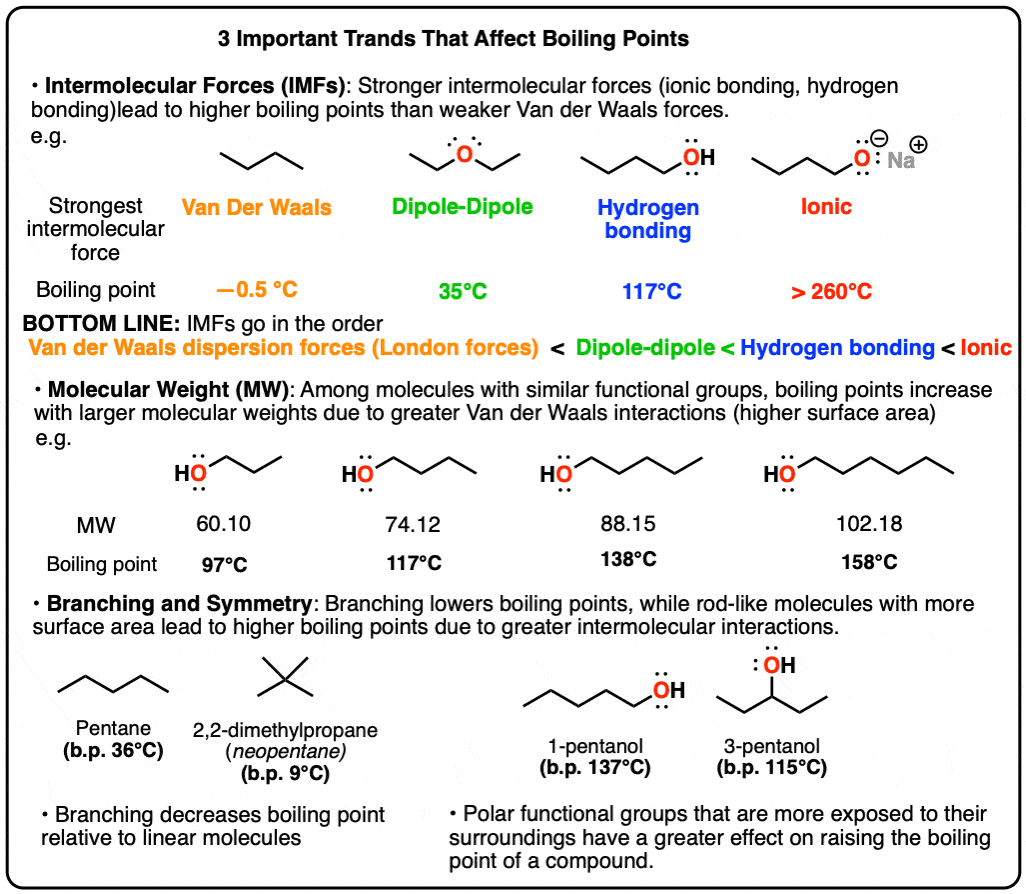
Table of Contents
- Trend #1: The Relative Strength Of The Four Intermolecular Forces
- Trend #2 – For Molecules With A Given Functional Group, Boiling Point Increases With Increasing Molecular Weight
- The Role Of Symmetry (or lack thereof) On Melting And Boiling Points
- Notes
- Quiz Yourself!
1. Trend #1: The relative strength of the four intermolecular forces .
Compare the different butane alcohol derivatives shown below. Molecules of diethyl ether, C4H10 O, are held together by dipole-dipole interactions which arise due to the polarized C-O bonds.
Compare the boiling point of diethyl ether (35 °C)with that of Its isomer 1-butanol (117 °C). The greatly increased boiling point is due to the fact that butanol contains a hydroxyl group, which is capable of hydrogen bonding.
Still, the attractive forces in butanol pale in comparison to those of the salt sodium butoxide, which melts at an extremely high temperature (well above 260 °C) and actually decomposes before it can turn into a liquid and boil.
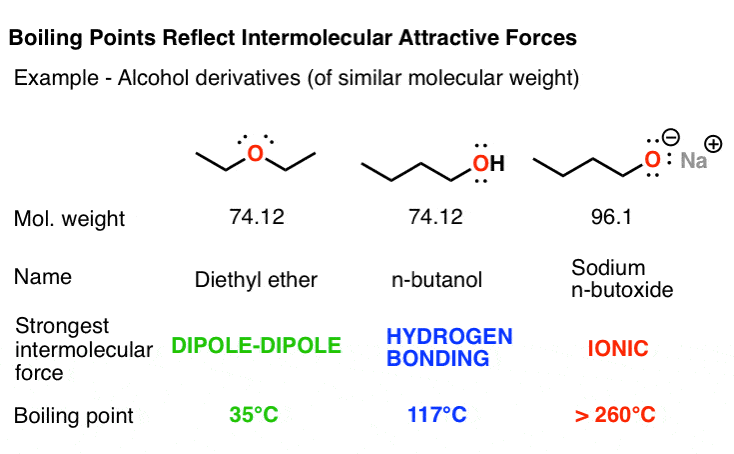
Then think about butane, C4H10, which contains no polar functional groups. The only attractive forces between individual butane molecules are the relatively weak Van der Waals dispersion forces. The result is that butane boils at the temperature at which water freezes (0° C), far below even that of diethyl ether.
Moral of the story: among molecules with roughly similar molecular weights, the boiling points will be determined by the functional groups present.
You could tell a similar tale for the similar amine and carboxylic acid isomers shown below.
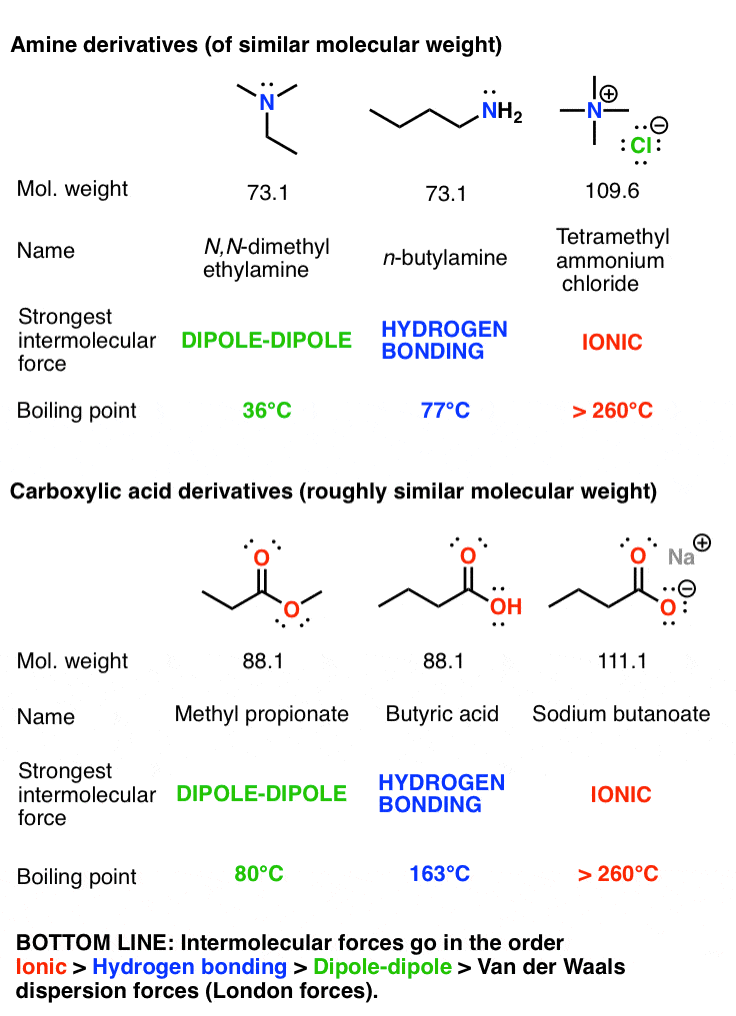
For a previous discussion of the 4 intermolecular forces, see the previous article (The Four Intermolecular Forces And How They Affect Boiling Points)
2. Trend #2 – For molecules with a given functional group, boiling point increases with molecular weight.
Look at the dramatic increases in boiling points as you increase molecular weight in all of these series:
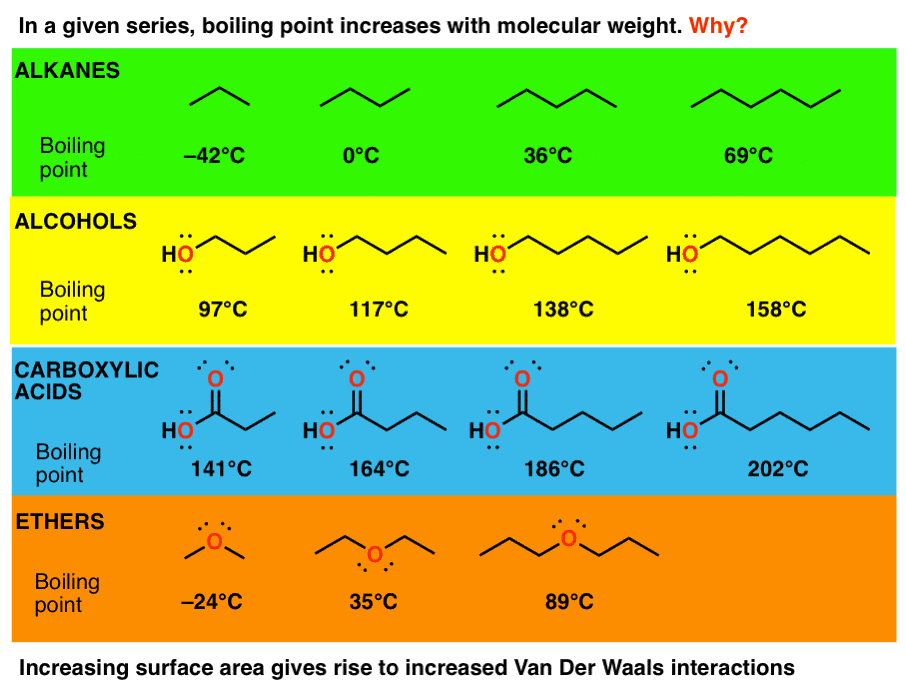
Here’s the question: How, exactly do intermolecular forces increase as molecular weight increases?
Well, the key force that is acting here are Van der Waals dispersion forces, which are proportional to surface area. So as you increase the length of the chain, you also increase the surface area, which means that you increase the ability of individual molecules to attract each other.
On an intuitive level, you could compare these long molecules to strands of spaghetti – the longer the noodles, the more work it takes to pull them apart. As the chain length increases, there will be regions where they can line up next to each other extremely well.
Individually, each interaction might not be worth very much, but when you add them all up over the length of a chain, Van der Waals dispersion forces can exert tremendous effects.
3. The Role Of Symmetry (or lack thereof) On Melting And Boiling Points
This is another byproduct of the surface-area dependence of Van der Waals dispersion forces – the more rod-like the molecules are, the better able they will be to line up and bond.
To take another intuitive pasta example, what sticks together more: spaghetti or macaroni? The more spherelike the molecule, the lower its surface area will be and the fewer intermolecular Van der Waals interactions will operate. Compare the boiling points of pentane (36°C) and 2,2-dimethyl propane (9 °C).
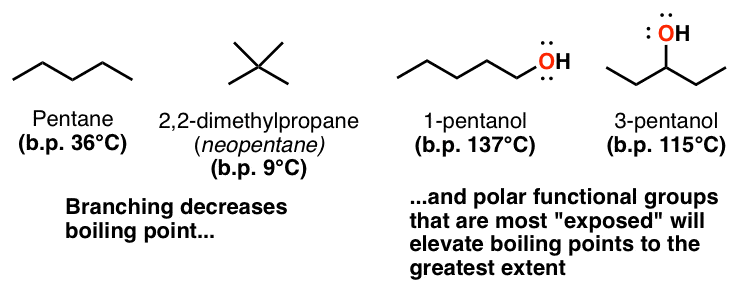
It can also apply to hydrogen bonding molecules like alcohols – compare the boiling points of 1-pentanol to 2-pentanol and 3-pentanol, for instance. The hydroxyl group of 1-pentanol is more “exposed” than it is in 3-pentanol (which is flanked by two bulky alkyl groups), so it will be better able to hydrogen bond with its fellows.
In summary, there are three main factors you need to think about when confronted with a question about boiling points. 1) what intermolecular forces will be present in the molecules? 2) how do the molecular weights compare? 3) how do the symmetries compare?
One last quick question for the road (see comments for answer).
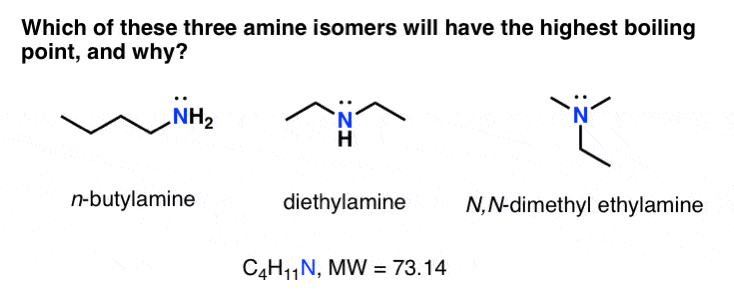
Notes
Related Articles
- The Four Intermolecular Forces and How They Affect Boiling Points
- Branching, and Its Affect On Melting and Boiling Points
- How To Use Electronegativity To Determine Electron Density (and why NOT to trust formal charge)
- Introduction to Resonance
- How To Use Curved Arrows To Interchange Resonance Forms
- Hybrid Orbitals and Hybridization
- Dipole Moments and Dipoles
P.S. New! Check out this free 3-page handout on solving common boiling point exam problems!
MOC_Boiling_Point_Handout (PDF)
Note 1. Some physical properties for alkanes
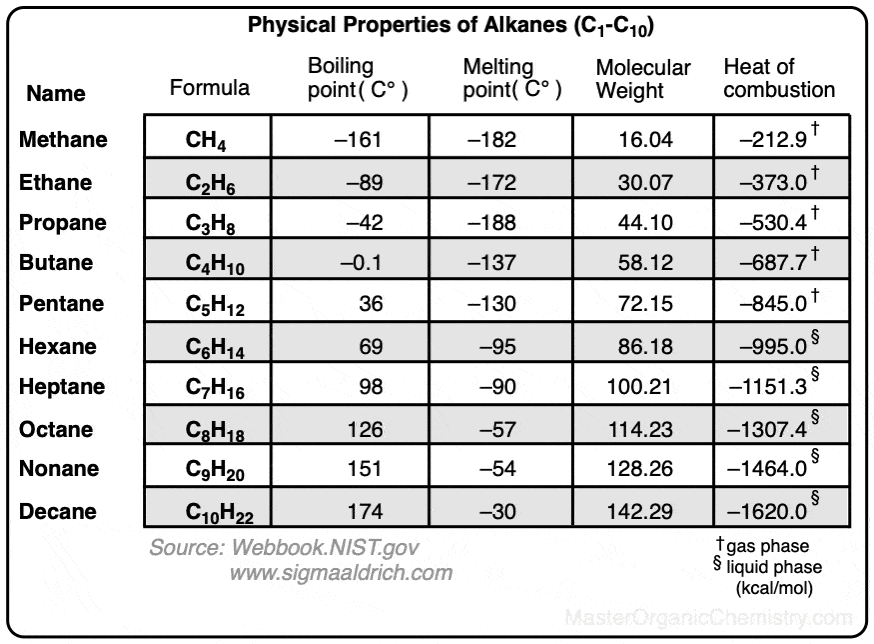
Note 2. Physical properties for higher alkanes (undecane, dodecane, tridecane, tetradecane, pentadecane, hexadecane, heptadecane, octadecane, nonadecane, and eicosane.
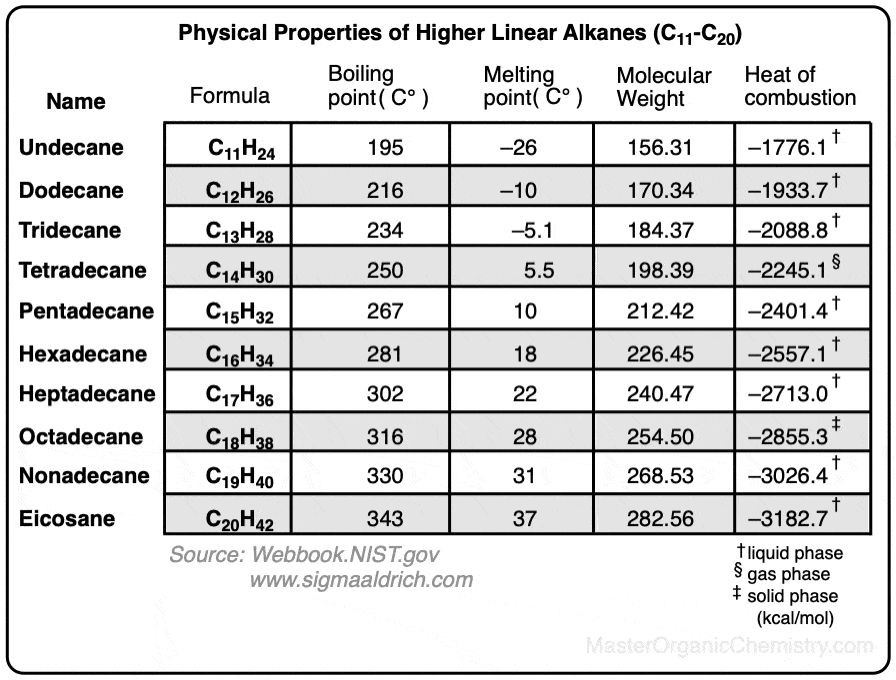
Quiz Yourself!
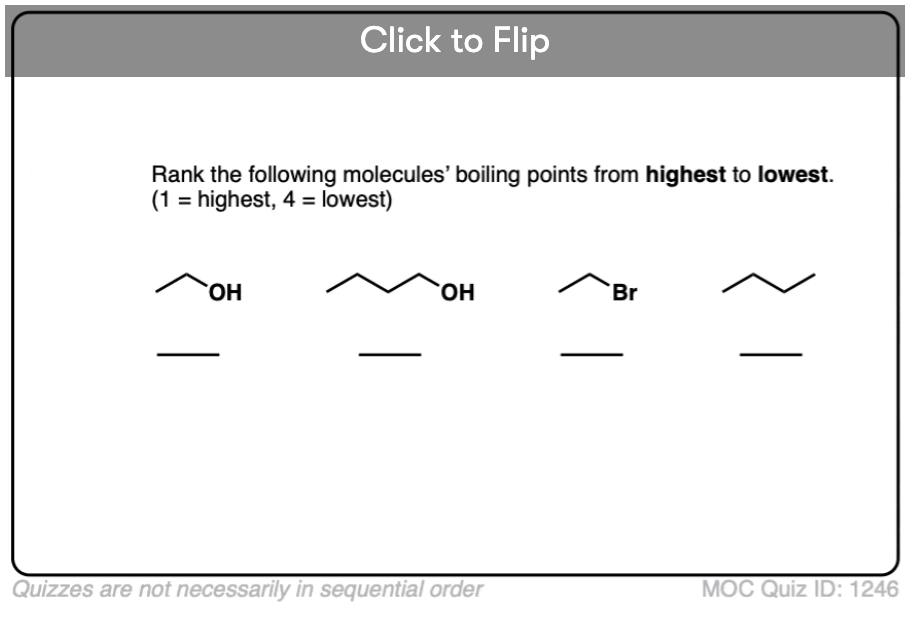
Become a MOC member to see the clickable quiz with answers on the back.
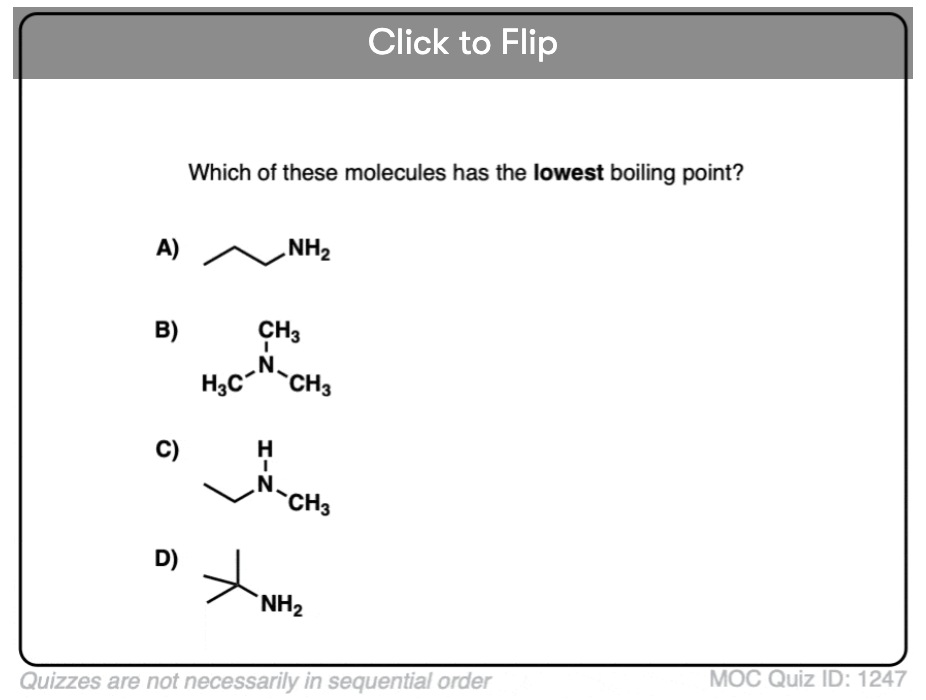
Become a MOC member to see the clickable quiz with answers on the back.
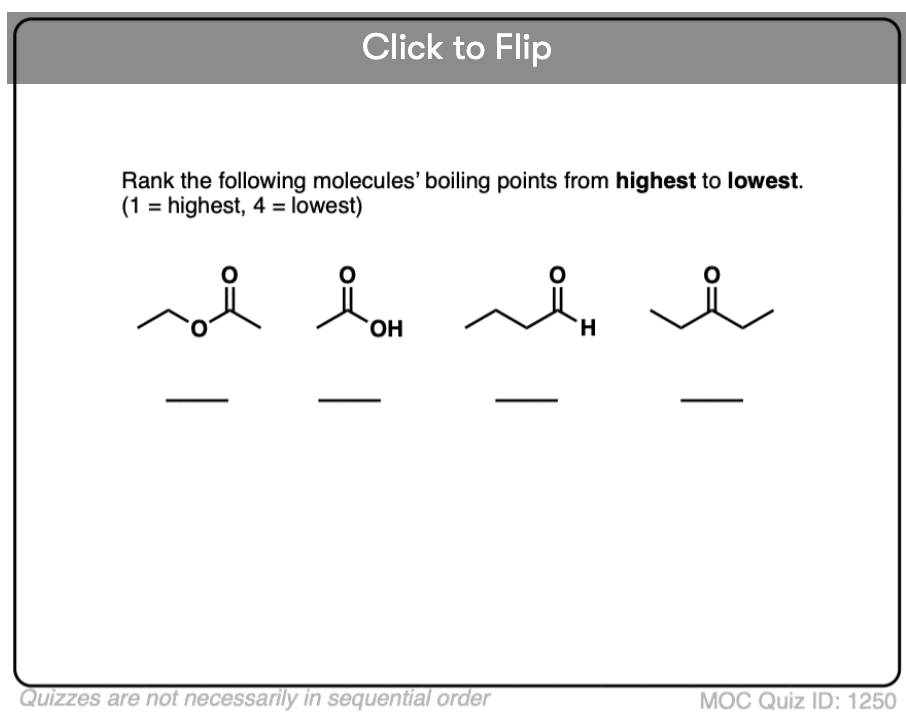
Become a MOC member to see the clickable quiz with answers on the back.
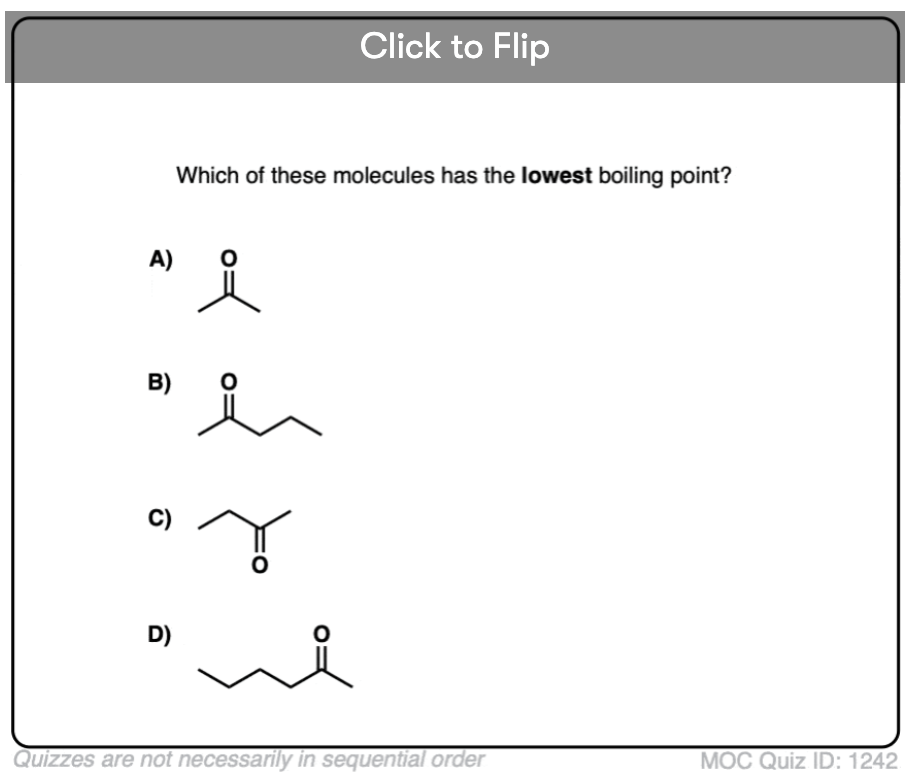
Become a MOC member to see the clickable quiz with answers on the back.
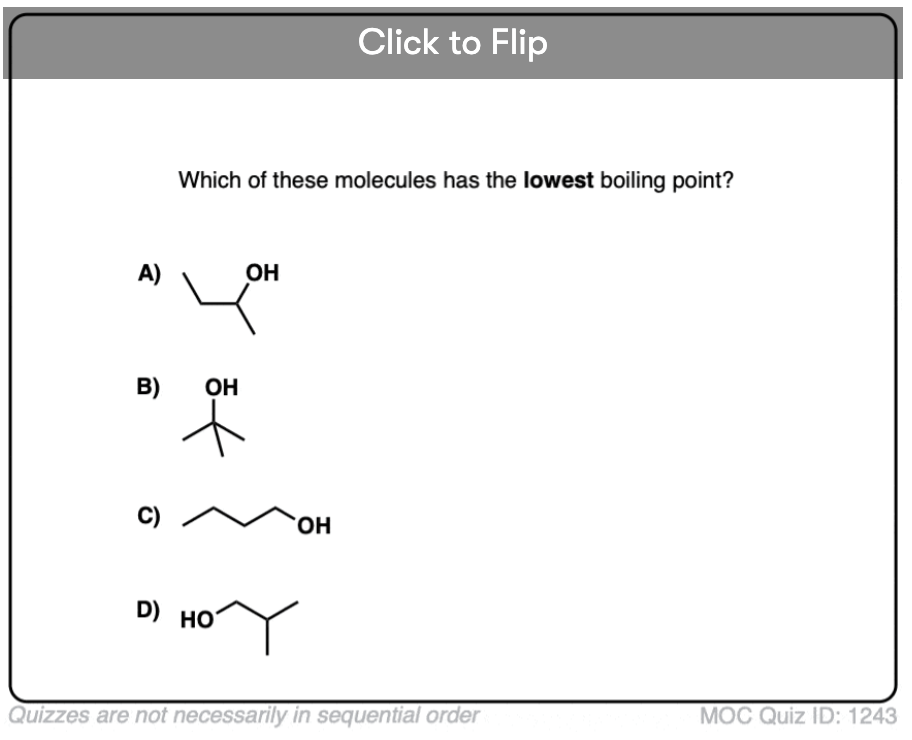
Become a MOC member to see the clickable quiz with answers on the back.
00 General Chemistry Review
01 Bonding, Structure, and Resonance
- How Do We Know Methane (CH4) Is Tetrahedral?
- Hybrid Orbitals and Hybridization
- How To Determine Hybridization: A Shortcut
- Orbital Hybridization And Bond Strengths
- Sigma bonds come in six varieties: Pi bonds come in one
- Dipole Moments and Dipoles
- A Key Skill: How to Calculate Formal Charge
- The Four Intermolecular Forces and How They Affect Boiling Points
- 3 Trends That Affect Boiling Points
- How To Use Electronegativity To Determine Electron Density (and why NOT to trust formal charge)
- Introduction to Resonance
- How To Use Curved Arrows To Interchange Resonance Forms
- Evaluating Resonance Forms (1) - The Rule of Least Charges
- How To Find The Best Resonance Structure By Applying Electronegativity
- Evaluating Resonance Structures With Negative Charges
- Evaluating Resonance Structures With Positive Charge
- Exploring Resonance: Pi-Donation
- Exploring Resonance: Pi-acceptors
- In Summary: Evaluating Resonance Structures
- Drawing Resonance Structures: 3 Common Mistakes To Avoid
- How to apply electronegativity and resonance to understand reactivity
- Bond Hybridization Practice
- Structure and Bonding Practice Quizzes
- Resonance Structures Practice
02 Acid Base Reactions
- Introduction to Acid-Base Reactions
- Acid Base Reactions In Organic Chemistry
- The Stronger The Acid, The Weaker The Conjugate Base
- Walkthrough of Acid-Base Reactions (3) - Acidity Trends
- Five Key Factors That Influence Acidity
- Acid-Base Reactions: Introducing Ka and pKa
- How to Use a pKa Table
- The pKa Table Is Your Friend
- A Handy Rule of Thumb for Acid-Base Reactions
- Acid Base Reactions Are Fast
- pKa Values Span 60 Orders Of Magnitude
- How Protonation and Deprotonation Affect Reactivity
- Acid Base Practice Problems
03 Alkanes and Nomenclature
- Meet the (Most Important) Functional Groups
- Condensed Formulas: Deciphering What the Brackets Mean
- Hidden Hydrogens, Hidden Lone Pairs, Hidden Counterions
- Don't Be Futyl, Learn The Butyls
- Primary, Secondary, Tertiary, Quaternary In Organic Chemistry
- Branching, and Its Affect On Melting and Boiling Points
- The Many, Many Ways of Drawing Butane
- Wedge And Dash Convention For Tetrahedral Carbon
- Common Mistakes in Organic Chemistry: Pentavalent Carbon
- Table of Functional Group Priorities for Nomenclature
- Summary Sheet - Alkane Nomenclature
- Organic Chemistry IUPAC Nomenclature Demystified With A Simple Puzzle Piece Approach
- Boiling Point Quizzes
- Organic Chemistry Nomenclature Quizzes
04 Conformations and Cycloalkanes
- Staggered vs Eclipsed Conformations of Ethane
- Conformational Isomers of Propane
- Newman Projection of Butane (and Gauche Conformation)
- Introduction to Cycloalkanes
- Geometric Isomers In Small Rings: Cis And Trans Cycloalkanes
- Calculation of Ring Strain In Cycloalkanes
- Cycloalkanes - Ring Strain In Cyclopropane And Cyclobutane
- Cyclohexane Conformations
- Cyclohexane Chair Conformation: An Aerial Tour
- How To Draw The Cyclohexane Chair Conformation
- The Cyclohexane Chair Flip
- The Cyclohexane Chair Flip - Energy Diagram
- Substituted Cyclohexanes - Axial vs Equatorial
- Ranking The Bulkiness Of Substituents On Cyclohexanes: "A-Values"
- Cyclohexane Chair Conformation Stability: Which One Is Lower Energy?
- Fused Rings - Cis-Decalin and Trans-Decalin
- Naming Bicyclic Compounds - Fused, Bridged, and Spiro
- Bredt's Rule (And Summary of Cycloalkanes)
- Newman Projection Practice
- Cycloalkanes Practice Problems
05 A Primer On Organic Reactions
- The Most Important Question To Ask When Learning a New Reaction
- Curved Arrows (for reactions)
- Nucleophiles and Electrophiles
- The Three Classes of Nucleophiles
- Nucleophilicity vs. Basicity
- What Makes A Good Nucleophile?
- What Makes A Good Leaving Group?
- 3 Factors That Stabilize Carbocations
- Equilibrium and Energy Relationships
- 7 Factors that stabilize negative charge in organic chemistry
- 7 Factors That Stabilize Positive Charge in Organic Chemistry
- What's a Transition State?
- Hammond's Postulate
- Learning Organic Chemistry Reactions: A Checklist (PDF)
06 Free Radical Reactions
- Free Radical Reactions
- 3 Factors That Stabilize Free Radicals
- Bond Strengths And Radical Stability
- Free Radical Initiation: Why Is "Light" Or "Heat" Required?
- Initiation, Propagation, Termination
- Monochlorination Products Of Propane, Pentane, And Other Alkanes
- Selectivity In Free Radical Reactions
- Selectivity in Free Radical Reactions: Bromination vs. Chlorination
- Halogenation At Tiffany's
- Allylic Bromination
- Bonus Topic: Allylic Rearrangements
- In Summary: Free Radicals
- Synthesis (2) - Reactions of Alkanes
- Free Radicals Practice Quizzes
07 Stereochemistry and Chirality
- Types of Isomers: Constitutional Isomers, Stereoisomers, Enantiomers, and Diastereomers
- How To Draw The Enantiomer Of A Chiral Molecule
- How To Draw A Bond Rotation
- Introduction to Assigning (R) and (S): The Cahn-Ingold-Prelog Rules
- Assigning Cahn-Ingold-Prelog (CIP) Priorities (2) - The Method of Dots
- Enantiomers vs Diastereomers vs The Same? Two Methods For Solving Problems
- Assigning R/S To Newman Projections (And Converting Newman To Line Diagrams)
- How To Determine R and S Configurations On A Fischer Projection
- The Meso Trap
- Optical Rotation, Optical Activity, and Specific Rotation
- Optical Purity and Enantiomeric Excess
- What's a Racemic Mixture?
- Chiral Allenes And Chiral Axes
- Stereochemistry Practice Problems and Quizzes
08 Substitution Reactions
- Nucleophilic Substitution Reactions - Introduction
- Two Types of Nucleophilic Substitution Reactions
- The SN2 Mechanism
- Why the SN2 Reaction Is Powerful
- The SN1 Mechanism
- The Conjugate Acid Is A Better Leaving Group
- Comparing the SN1 and SN2 Reactions
- Polar Protic? Polar Aprotic? Nonpolar? All About Solvents
- Steric Hindrance is Like a Fat Goalie
- Common Blind Spot: Intramolecular Reactions
- Substitution Practice - SN1
- Substitution Practice - SN2
09 Elimination Reactions
- Elimination Reactions (1): Introduction And The Key Pattern
- Elimination Reactions (2): The Zaitsev Rule
- Elimination Reactions Are Favored By Heat
- Two Elimination Reaction Patterns
- The E1 Reaction
- The E2 Mechanism
- E1 vs E2: Comparing the E1 and E2 Reactions
- Antiperiplanar Relationships: The E2 Reaction and Cyclohexane Rings
- Bulky Bases in Elimination Reactions
- Comparing the E1 vs SN1 Reactions
- Elimination (E1) Reactions With Rearrangements
- E1cB - Elimination (Unimolecular) Conjugate Base
- Elimination (E1) Practice Problems And Solutions
- Elimination (E2) Practice Problems and Solutions
10 Rearrangements
11 SN1/SN2/E1/E2 Decision
- Identifying Where Substitution and Elimination Reactions Happen
- Deciding SN1/SN2/E1/E2 (1) - The Substrate
- Deciding SN1/SN2/E1/E2 (2) - The Nucleophile/Base
- SN1 vs E1 and SN2 vs E2 : The Temperature
- Deciding SN1/SN2/E1/E2 - The Solvent
- Wrapup: The Key Factors For Determining SN1/SN2/E1/E2
- Alkyl Halide Reaction Map And Summary
- SN1 SN2 E1 E2 Practice Problems
12 Alkene Reactions
- E and Z Notation For Alkenes (+ Cis/Trans)
- Alkene Stability
- Alkene Addition Reactions: "Regioselectivity" and "Stereoselectivity" (Syn/Anti)
- Stereoselective and Stereospecific Reactions
- Hydrohalogenation of Alkenes and Markovnikov's Rule
- Hydration of Alkenes With Aqueous Acid
- Rearrangements in Alkene Addition Reactions
- Halogenation of Alkenes and Halohydrin Formation
- Oxymercuration Demercuration of Alkenes
- Hydroboration Oxidation of Alkenes
- m-CPBA (meta-chloroperoxybenzoic acid)
- OsO4 (Osmium Tetroxide) for Dihydroxylation of Alkenes
- Palladium on Carbon (Pd/C) for Catalytic Hydrogenation of Alkenes
- Cyclopropanation of Alkenes
- A Fourth Alkene Addition Pattern - Free Radical Addition
- Alkene Reactions: Ozonolysis
- Oxidative Cleavage of Vicinal Diols With NaIO4 and Pb(OAc)4
- Summary: Three Key Families Of Alkene Reaction Mechanisms
- Synthesis (4) - Alkene Reaction Map, Including Alkyl Halide Reactions
- Alkene Reactions Practice Problems
13 Alkyne Reactions
- Acetylides from Alkynes, And Substitution Reactions of Acetylides
- Partial Reduction of Alkynes With Lindlar's Catalyst
- Partial Reduction of Alkynes With Na/NH3 To Obtain Trans Alkenes
- Alkyne Hydroboration With "R2BH"
- Hydration and Oxymercuration of Alkynes
- Hydrohalogenation of Alkynes
- Alkyne Halogenation: Bromination and Chlorination of Alkynes
- Oxidation of Alkynes With O3 and KMnO4
- Alkenes To Alkynes Via Halogenation And Elimination Reactions
- Alkynes Are A Blank Canvas
- Synthesis (5) - Reactions of Alkynes
- Alkyne Reactions Practice Problems With Answers
14 Alcohols, Epoxides and Ethers
- Alcohols - Nomenclature and Properties
- Alcohols Can Act As Acids Or Bases (And Why It Matters)
- Alcohols - Acidity and Basicity
- The Williamson Ether Synthesis
- Ethers From Alkenes, Tertiary Alkyl Halides and Alkoxymercuration
- Alcohols To Ethers via Acid Catalysis
- Cleavage Of Ethers With Acid
- Epoxides - The Outlier Of The Ether Family
- Opening of Epoxides With Acid
- Epoxide Ring Opening With Base
- Making Alkyl Halides From Alcohols
- Tosylates And Mesylates
- PBr3 and SOCl2
- Elimination Reactions of Alcohols
- Elimination of Alcohols To Alkenes With POCl3
- Alcohol Oxidation: "Strong" and "Weak" Oxidants
- Demystifying The Mechanisms of Alcohol Oxidations
- Protecting Groups For Alcohols
- Thiols And Thioethers
- Calculating the oxidation state of a carbon
- Oxidation and Reduction in Organic Chemistry
- Oxidation Ladders
- SOCl2 Mechanism For Alcohols To Alkyl Halides: SN2 versus SNi
- Alcohol Reactions Roadmap (PDF)
- Alcohol Reaction Practice Problems
- Epoxide Reaction Quizzes
- Oxidation and Reduction Practice Quizzes
15 Organometallics
- What's An Organometallic?
- Formation of Grignard and Organolithium Reagents
- Organometallics Are Strong Bases
- Reactions of Grignard Reagents
- Protecting Groups In Grignard Reactions
- Synthesis Problems Involving Grignard Reagents
- Grignard Reactions And Synthesis (2)
- Organocuprates (Gilman Reagents): How They're Made
- Gilman Reagents (Organocuprates): What They're Used For
- The Heck, Suzuki, and Olefin Metathesis Reactions (And Why They Don't Belong In Most Introductory Organic Chemistry Courses)
- Reaction Map: Reactions of Organometallics
- Grignard Practice Problems
16 Spectroscopy
- Degrees of Unsaturation (or IHD, Index of Hydrogen Deficiency)
- Conjugation And Color (+ How Bleach Works)
- Introduction To UV-Vis Spectroscopy
- UV-Vis Spectroscopy: Absorbance of Carbonyls
- UV-Vis Spectroscopy: Practice Questions
- Bond Vibrations, Infrared Spectroscopy, and the "Ball and Spring" Model
- Infrared (IR) Spectroscopy: A Quick Primer On Interpreting Spectra
- IR Spectroscopy: 4 Practice Problems
- 1H NMR: How Many Signals?
- Homotopic, Enantiotopic, Diastereotopic
- Diastereotopic Protons in 1H NMR Spectroscopy: Examples
- 13-C NMR - How Many Signals
- Liquid Gold: Pheromones In Doe Urine
- Natural Product Isolation (1) - Extraction
- Natural Product Isolation (2) - Purification Techniques, An Overview
- Structure Determination Case Study: Deer Tarsal Gland Pheromone
17 Dienes and MO Theory
- What To Expect In Organic Chemistry 2
- Are these molecules conjugated?
- Conjugation And Resonance In Organic Chemistry
- Bonding And Antibonding Pi Orbitals
- Molecular Orbitals of The Allyl Cation, Allyl Radical, and Allyl Anion
- Pi Molecular Orbitals of Butadiene
- Reactions of Dienes: 1,2 and 1,4 Addition
- Thermodynamic and Kinetic Products
- More On 1,2 and 1,4 Additions To Dienes
- s-cis and s-trans
- The Diels-Alder Reaction
- Cyclic Dienes and Dienophiles in the Diels-Alder Reaction
- Stereochemistry of the Diels-Alder Reaction
- Exo vs Endo Products In The Diels Alder: How To Tell Them Apart
- HOMO and LUMO In the Diels Alder Reaction
- Why Are Endo vs Exo Products Favored in the Diels-Alder Reaction?
- Diels-Alder Reaction: Kinetic and Thermodynamic Control
- The Retro Diels-Alder Reaction
- The Intramolecular Diels Alder Reaction
- Regiochemistry In The Diels-Alder Reaction
- The Cope and Claisen Rearrangements
- Electrocyclic Reactions
- Electrocyclic Ring Opening And Closure (2) - Six (or Eight) Pi Electrons
- Diels Alder Practice Problems
- Molecular Orbital Theory Practice
18 Aromaticity
- Introduction To Aromaticity
- Rules For Aromaticity
- Huckel's Rule: What Does 4n+2 Mean?
- Aromatic, Non-Aromatic, or Antiaromatic? Some Practice Problems
- Antiaromatic Compounds and Antiaromaticity
- The Pi Molecular Orbitals of Benzene
- The Pi Molecular Orbitals of Cyclobutadiene
- Frost Circles
- Aromaticity Practice Quizzes
19 Reactions of Aromatic Molecules
- Electrophilic Aromatic Substitution: Introduction
- Activating and Deactivating Groups In Electrophilic Aromatic Substitution
- Electrophilic Aromatic Substitution - The Mechanism
- Ortho-, Para- and Meta- Directors in Electrophilic Aromatic Substitution
- Understanding Ortho, Para, and Meta Directors
- Why are halogens ortho- para- directors?
- Disubstituted Benzenes: The Strongest Electron-Donor "Wins"
- Electrophilic Aromatic Substitutions (1) - Halogenation of Benzene
- Electrophilic Aromatic Substitutions (2) - Nitration and Sulfonation
- EAS Reactions (3) - Friedel-Crafts Acylation and Friedel-Crafts Alkylation
- Intramolecular Friedel-Crafts Reactions
- Nucleophilic Aromatic Substitution (NAS)
- Nucleophilic Aromatic Substitution (2) - The Benzyne Mechanism
- Reactions on the "Benzylic" Carbon: Bromination And Oxidation
- The Wolff-Kishner, Clemmensen, And Other Carbonyl Reductions
- More Reactions on the Aromatic Sidechain: Reduction of Nitro Groups and the Baeyer Villiger
- Aromatic Synthesis (1) - "Order Of Operations"
- Synthesis of Benzene Derivatives (2) - Polarity Reversal
- Aromatic Synthesis (3) - Sulfonyl Blocking Groups
- Birch Reduction
- Synthesis (7): Reaction Map of Benzene and Related Aromatic Compounds
- Aromatic Reactions and Synthesis Practice
- Electrophilic Aromatic Substitution Practice Problems
20 Aldehydes and Ketones
- What's The Alpha Carbon In Carbonyl Compounds?
- Nucleophilic Addition To Carbonyls
- Aldehydes and Ketones: 14 Reactions With The Same Mechanism
- Sodium Borohydride (NaBH4) Reduction of Aldehydes and Ketones
- Grignard Reagents For Addition To Aldehydes and Ketones
- Wittig Reaction
- Hydrates, Hemiacetals, and Acetals
- Imines - Properties, Formation, Reactions, and Mechanisms
- All About Enamines
- Breaking Down Carbonyl Reaction Mechanisms: Reactions of Anionic Nucleophiles (Part 2)
- Aldehydes Ketones Reaction Practice
21 Carboxylic Acid Derivatives
- Nucleophilic Acyl Substitution (With Negatively Charged Nucleophiles)
- Addition-Elimination Mechanisms With Neutral Nucleophiles (Including Acid Catalysis)
- Basic Hydrolysis of Esters - Saponification
- Transesterification
- Proton Transfer
- Fischer Esterification - Carboxylic Acid to Ester Under Acidic Conditions
- Lithium Aluminum Hydride (LiAlH4) For Reduction of Carboxylic Acid Derivatives
- LiAlH[Ot-Bu]3 For The Reduction of Acid Halides To Aldehydes
- Di-isobutyl Aluminum Hydride (DIBAL) For The Partial Reduction of Esters and Nitriles
- Amide Hydrolysis
- Thionyl Chloride (SOCl2) And Conversion of Carboxylic Acids to Acid Halides
- Diazomethane (CH2N2)
- Carbonyl Chemistry: Learn Six Mechanisms For the Price Of One
- Making Music With Mechanisms (PADPED)
- Carboxylic Acid Derivatives Practice Questions
22 Enols and Enolates
- Keto-Enol Tautomerism
- Enolates - Formation, Stability, and Simple Reactions
- Kinetic Versus Thermodynamic Enolates
- Aldol Addition and Condensation Reactions
- Reactions of Enols - Acid-Catalyzed Aldol, Halogenation, and Mannich Reactions
- Claisen Condensation and Dieckmann Condensation
- Decarboxylation
- The Malonic Ester and Acetoacetic Ester Synthesis
- The Michael Addition Reaction and Conjugate Addition
- The Robinson Annulation
- Haloform Reaction
- The Hell–Volhard–Zelinsky Reaction
- Enols and Enolates Practice Quizzes
23 Amines
- The Amide Functional Group: Properties, Synthesis, and Nomenclature
- Basicity of Amines And pKaH
- 5 Key Basicity Trends of Amines
- The Mesomeric Effect And Aromatic Amines
- Nucleophilicity of Amines
- Alkylation of Amines (Sucks!)
- Reductive Amination
- The Gabriel Synthesis
- Some Reactions of Azides
- The Hofmann Elimination
- The Hofmann and Curtius Rearrangements
- The Cope Elimination
- Protecting Groups for Amines - Carbamates
- The Strecker Synthesis of Amino Acids
- Introduction to Peptide Synthesis
- Reactions of Diazonium Salts: Sandmeyer and Related Reactions
- Amine Practice Questions
24 Carbohydrates
- D and L Notation For Sugars
- Pyranoses and Furanoses: Ring-Chain Tautomerism In Sugars
- What is Mutarotation?
- Reducing Sugars
- The Big Damn Post Of Carbohydrate-Related Chemistry Definitions
- The Haworth Projection
- Converting a Fischer Projection To A Haworth (And Vice Versa)
- Reactions of Sugars: Glycosylation and Protection
- The Ruff Degradation and Kiliani-Fischer Synthesis
- Isoelectric Points of Amino Acids (and How To Calculate Them)
- Carbohydrates Practice
- Amino Acid Quizzes
25 Fun and Miscellaneous
- A Gallery of Some Interesting Molecules From Nature
- Screw Organic Chemistry, I'm Just Going To Write About Cats
- On Cats, Part 1: Conformations and Configurations
- On Cats, Part 2: Cat Line Diagrams
- On Cats, Part 4: Enantiocats
- On Cats, Part 6: Stereocenters
- Organic Chemistry Is Shit
- The Organic Chemistry Behind "The Pill"
- Maybe they should call them, "Formal Wins" ?
- Why Do Organic Chemists Use Kilocalories?
- The Principle of Least Effort
- Organic Chemistry GIFS - Resonance Forms
- Reproducibility In Organic Chemistry
- What Holds The Nucleus Together?
- How Reactions Are Like Music
- Organic Chemistry and the New MCAT
26 Organic Chemistry Tips and Tricks
- Common Mistakes: Formal Charges Can Mislead
- Partial Charges Give Clues About Electron Flow
- Draw The Ugly Version First
- Organic Chemistry Study Tips: Learn the Trends
- The 8 Types of Arrows In Organic Chemistry, Explained
- Top 10 Skills To Master Before An Organic Chemistry 2 Final
- Common Mistakes with Carbonyls: Carboxylic Acids... Are Acids!
- Planning Organic Synthesis With "Reaction Maps"
- Alkene Addition Pattern #1: The "Carbocation Pathway"
- Alkene Addition Pattern #2: The "Three-Membered Ring" Pathway
- Alkene Addition Pattern #3: The "Concerted" Pathway
- Number Your Carbons!
- The 4 Major Classes of Reactions in Org 1
- How (and why) electrons flow
- Grossman's Rule
- Three Exam Tips
- A 3-Step Method For Thinking Through Synthesis Problems
- Putting It Together
- Putting Diels-Alder Products in Perspective
- The Ups and Downs of Cyclohexanes
- The Most Annoying Exceptions in Org 1 (Part 1)
- The Most Annoying Exceptions in Org 1 (Part 2)
- The Marriage May Be Bad, But the Divorce Still Costs Money
- 9 Nomenclature Conventions To Know
- Nucleophile attacks Electrophile
27 Case Studies of Successful O-Chem Students
- Success Stories: How Corina Got The The "Hard" Professor - And Got An A+ Anyway
- How Helena Aced Organic Chemistry
- From a "Drop" To B+ in Org 2 – How A Hard Working Student Turned It Around
- How Serge Aced Organic Chemistry
- Success Stories: How Zach Aced Organic Chemistry 1
- Success Stories: How Kari Went From C– to B+
- How Esther Bounced Back From a "C" To Get A's In Organic Chemistry 1 And 2
- How Tyrell Got The Highest Grade In Her Organic Chemistry Course
- This Is Why Students Use Flashcards
- Success Stories: How Stu Aced Organic Chemistry
- How John Pulled Up His Organic Chemistry Exam Grades
- Success Stories: How Nathan Aced Organic Chemistry (Without It Taking Over His Life)
- How Chris Aced Org 1 and Org 2
- Interview: How Jay Got an A+ In Organic Chemistry
- How to Do Well in Organic Chemistry: One Student's Advice
- "America's Top TA" Shares His Secrets For Teaching O-Chem
- "Organic Chemistry Is Like..." - A Few Metaphors
- How To Do Well In Organic Chemistry: Advice From A Tutor
- Guest post: "I went from being afraid of tests to actually looking forward to them".
As the number of carbon Atoms increases their molecular mass increases and their vanderwalls force of attraction increases and this leads to increases in boiling points of higher hydrocarbon chains
What causes the boiling point of higher hydrocarbons to be high?
Which one has higher boiling point CH3OH or CH3CH2OH
That’s something you can easily look up!
I am trying to figure out if acetic acid will evaporate or not in the drying step of my compound after treating the solution with NaOH to a pH around 8
Is your compound water soluble or organic soluble? Because if it’s soluble in organic solvent, you can avoid worrying about this by just extracting with something like ethyl acetate.
If your compound is water soluble and you are drying it through rotary evaporation / distillation, the acetic acid and water will evaporate at similar rates. At the end you will have NaOH / NaOAc salts however.
Thank you James.
Remaining with the same example (in the extremes as you said), if I make the solution of diluted acetic acid completely boil in a beaker as to remove water, what will remain in the beaker? Acetate salts?
Are you trying to purify acetic acid?
Take for example a diluted solution of acetic acid in water. Will the bp of acetic acid change at acidic pH or basic pH?
It’s hard to answer this question without more specific detail.
In the extremes, it’s easy to answer. For instance if H2O is protonated *completely* with a strong acid, it becomes H3O+ . Being a charged compound it therefore has a very low volatility (this is why H2SO4 is often used to remove water). The same is true when H2O is completely deprotonated to NaOH.
The same would hold for acetic acid if it was either protonated completely or deprotonated completely. Salts are not volatile.
How do I separate isomers with close boiling points
Is column chromatography an option? That’s usually the main method unless you have a lot of material to separate. There’s a reason refineries are so large, they’re essentially huge distillation operations!
Which of the following has higher boiling point? And why?
CH3CH2OH and HOCH2CH2OH
Count the number of functional groups capable of hydrogen bonding.
Why does 2-butyne have a higher BP than 1-butyne?
Good question. I’m not surprised 2-butyne has a higher melting point – it’s more rigid (fewer degrees of freedom for a methyl group compared to an ethyl group) and therefore should stack together much more easily than 1-butyne. I suppose the same factors are at play in the boiling point as well – rigid structure leads to greater overall surface contact between molecules, meaning stronger VDW dispersion factors, meaning higher boiling point.
Why boiling point of alcohol increase as molecular weight increase
Increase of surface area. Increased surface area means more van der Waals interactions, which will increase boiling point.
Rank the following from lowest to highest anticipated boiling points: C2H2, CH4, Ne, H3COCH3.
Start by asking yourself what intermolecular forces are possible in each of these molecules.
this is very helpful, boiling point started to make sense already by that list at the beginning. before finding this i was looking through my class notes and textbook trying to find out what made a difference in a molecules boiling point and i couldnt find a good answer.using this page i was able to answer a question on my assignment. i’m going to study the printable sheet so that it’s easier next time.
Cool, I’m glad you found the sheet helpful Megan. Learning the trends is key!
A little confused on this, isn’t boiling point a colligative property? So the boiling point elevation depends only on the number of particles present in a solution, not the nature of those particles? Or does that colligative property factor only apply for ionic bonds – which is why they’re so much higher boiling points compared to the organic molecules.
We’re not dealing with solutes & solutions here, just the boiling points of the liquids by themselves. Each pure compound has a distinct boiling point which depends on the intermolecular attractive forces.
Can you please explain why ethoxy ethane have a lower boiling point than n-pentane?
What about the higher boiling point of methoxy ethane when compared to n-butane?
Isn’t it contradictory?
That is a pretty wild fact, isn’t it. You would not expect that diethyl ether would have a lower boiling point than pentane.
Thanks a lot….. It helped a lot. Also the sheet is pretty amazing.
Cool. Thanks Sourabh.
Great resource, even for Organic Instructors! Thank you for making the content concise and easy to understand!
Here, I summarized some boiling point of halobutane alkyl chain by increasing boiling point order. With that in hands, it’s eazier to see the trend of adding different halogen atom even mixing them on a butane alkyl chain.
Perfluorobutane bp: -7`C
Butane bp: -0.5`C
1-Fluorobutane bp: 32`C
1-Chlorobutane bp: 77-78`C
1-Bromobutane bp: 100-104`C
1-Iodo-tert-butyl bp: 118-120`C
2-bromo-2-chlorobutane bp: 120`C
2-bromo-1-chloro-2-methylpropane bp: 127`C
1-Iodobutane bp: 130-131`C
1-Bromo-4-fluorobutane bp: 134-135`C
1-bromo-3-chloro-2-methylpropane bp: 153`C
1-Bromo-3-chlorobutane bp: 154`C
1,4-Dichlorobutane bp: 161-163`C
1-Bromo-4-chlorobutane bp: 177-180`C (80-82`C/30 mmHg)
1,4-Dibromobutane bp: 195-198`C (63-65`C/6 mmHg)
1-Chloro-4-iodobutane bp: 201-201`C (88-89`C mmHg)
1,4-Diodobutane bp: 261-267`C (147-152`C/26 mmHg)
octane bp:125-127`C
1-Fluorooctane: 142-146`C
1-chlorooctane bp: 183`C
1-bromooctane bp: 201`C
How chlorine will affect the boiling point of a alkyl chain for exemple 1-chloro-octane compare to octane?
And for 1-bromo-octane?
And for 1-bromo-8-chloro-octane?
Thanks, this was super helpful!!!
Glad you found it helpful!
Nice, really appreciate your broadness without sticking to a job. Society might wish in a bigger way than what you had opted earlier…One thing Dear professor James , when we are discussing about boiling point , I have to say that, does the factors like sterically hinderedness of a molecule come to scenario or we shall ignore about the effects.
Let you know that I am working as an assistant professor in the University, India. Welcome you and your page with open arms.
Thanks…you made it extremely understandable….
thanks a lot…
I want to know, how water content in crystallized substance affects its melting point. The main reason behind this question is that after synthesizing benzoic acid, its melting point was found to be high, i had to give certain errors that increase the % yield. So, to verify that water was present in the solid crystals, If i can justify that melting point was higher than expected due to presence of water, the error of increased % yield will be justified
Water will generally lead to depression of the melting point, not raising it.
Why does trans but-2-ene has higher melting point but lower boiling point than cis but-2-ene? Is this because of dipole moment?
Hey there, just wanted to stop by to say how much I appreciate this website. You have an exceptional ability to present material in a concise, understandable fashion. I wish you were the author of my organic chemistry book or my professor, because this year I have been teaching myself organic chemistry using your website and my textbook (lecturer is awful) and received an A+ in ochem 1. Thank you!
Hey RJ, thank you for the kind commment, and I appreciate you stopping by to say so. James
Why does NO2 have a greater boiling point than SO2? Both are polar, dipole-dipole interactions, but SO2 has a greater dipole moment, greater molar mass, and greater surface area. I know NO2 is a radical, does that affect boiling point?
I understand branching increases M.P but I don’t totally understand d reason..
Thank you! I’m studying chemistry at my college and this was very helpful! I normally hate and can barely understand chemistry but this made it very clear and easy to understand so thank you :)
Glad to hear it Jillian! Thank you for your comment!
I am having a little problem in understanding the melting point trends……why the following melting point increase is uneven……….formic acid(m.p 8.4) then ethanoic acid(m.p 16)…but then propanoic acid (m.p -21)…..then pentanoic acid (m.p -35)…………………It seems appropriate to understand boiling point trends which increase with molecular size as van der waals forces incrase but how does melting point trend works?
Thanks in advance!
Thanks for this!
I am also taking Orgo I and came across a problem I couldn’t figure out. Given 3 alcohols : tert-butyl, sec-butyl, and n-butyl with their respective boiling point measurements at : 82C, 100C, and 117C. 4 carbons, same molecular weight for all them, same intermolecular forces? What creates the differences in their boiling point values? Is it the location of the hydroxyl groups?
Thanks for your help!
The key factor will be surface area. The linear chains have a higher surface area than the branched alkyl groups (which are more “spherical”) and since van der waals forces are proportional to boiling point, the linear alkyl groups should have higher boiling point.
Thanks James! extremely helpful. Now iam clear about the concepts. Please do keep posting such concepts.
Readable. Hurumph!
What a great summary, and really reafable. I’ve been struggling to get to grips with Chemistry as part of a course I’m doing. This is the best site I’ve found, thank you for putting things in terms I truly understand!
thanks Jackie!
Please tell me why is the boiling point of Butan-1-ol greater than that of butan-2-ol?
I cannot not leave a comment. Thank you so much :)) I’m currently taking up Organic Chemistry and this has helped a lot!
Determine the order with lowest boiling point on the left:
A = (CH3)3CCH2CH2CH2CH2CH2C(CH3)3
B = CH3CH2C(CH3)2C(CH3)2C(CH3)2CH2CH3
C = (CH3)2CHCH2C(CH3)2C(CH3)2CH2CH2CH3
All three have the same number of carbons and the same number of branch points. Help!
This does not explain boiling point.
I’m actually studying for my DAT and this was an amazing review and help…Thank you
Great. Glad you find it helpful for the DAT Nikki!
Why does branching in alkanes lows the boiling point …?
Branching reduced the ability of a molecule to ‘stack,’ making its state less solid and its boiling point lower.
what if we have different compounds with huge difference in milecular weight
In this case we’d be comparing two different variables (chain length *and* polarity of functional groups) and it is difficult to predict which factor is more important. I would look for examples of compounds you are curious about and compare their known melting points/boiling points.
which will have the higher boiling point, C6H14 or C2H5OH and why ?
Does vander walls force mean the same thing as dipole induced dipole force?
It’s probably way too late..but no, it isn’t the same thing. Dipole-induced dipole is describing the attractive forces between a polar molecule (dipole) and an induced dipole (dispersion, london, van der waals). Instead of looking at one isolated force (such as disperson), dipole-induced dipole is describing two that are attracted to eachother…temporarily in the case of induced dipole.
Thank you so much, i’ve been looking for something clear and easy to understand about trends in boiling points and this has answered so many of my questions! Keep up the fantastic work.
do we only can compare the molecular size and molecular shape for the similar molecules or we can compare the size and shape for molecules with different functional groups ? for example can i compare the size and shape of pentanoic acid with heptane ?
It’s tricky to compare two variables (chain length and functional group) at once. Generally you just want to know the impact of each variable individually.
Hi thanks for this info helps a lot but I have a question. It concerns organic compounds. Say you have a ketone such as heptanone. So the boiling point of this compound should be relatively high because it has a large surface area and it is a polar molecule so there are dipole -dipole forces present. Now take a alcohol that is a shorter chain such as propanol. Alcohol should have a higher boiling point because it has a hygrogen bond. But the propanol molecule is a much shorter chain so it has a smaller surface area than the heptanone. So how can we work out which one has a higher boiling point? (In this case heptanone has a higher boiling point than propanol but I would like an explanation as to why.)
Hi Lil, it’s difficult to compare two variables at once because it’s hard to gauge the relative importance of each variable from first principles alone [this is what experiments are for]. In the example mentioned, comparing heptanone and propanol is difficult because we’re comparing two variables at once: chain length and the polarity of the functional group. The key takeaway from this article is that if all variables except one are the same, you can predict boiling points based on these concepts. You’ll find that exams will generally test one variable too.
If we have a molecule with hydrogen bond and one alkane. If alkane has greater molecular weight than hydrogen bond, which on has highest boiling point?
I don’t understand why octane has a higher BP than chloropentane.
You’re comparing two different variables there; chain length (8 carbons vs. 5 carbons) and polarity (chlorine is electronegative). It’s hard to predict how boiling points are affected when you change more than one variable.
Why CCl4 has greater boiling point than CH4 ?? ( CH4 has more H bonds )
Higher molecular weight is one thing. C-H does not count as a “hydrogen bond’ because carbon is not electronegative enough. Only O-H, N-H and F-H bonds participate in hydrogen bonding.
this was quite insightful, but i have a problem i was given a question to compare pentane and diethyl ether. Based on the information i have seen it looks like pentane has a higher boiling point than di-ethyl ether, based on actual BP but your information tells me that it should be otherwise as diethyl ether has dipole-dipole interactions and pentane has van der waal forces. Could you clear up for me which should actual have the higher BP and give a reason for the answer?
Excellent point! I don’t have a good answer as to why pentane’s BP (36 deg C) is higher than Et2O(34.5 deg C). Interestingly the boiling point of tetrahydrofuran (C4H8O) is 66 deg C, because the ring gives it a permanent dipole moment.
pentane has higher bp due to more no. of C atoms.
but butane has lower bp than diethyl ether due to the reason you’ve mentioned
I’m cramming for the OAT and this table helped a LOT! Thanks!
This is an amazing reference that simplifies properties affecting boiling point, which can be confusing when it comes to the many factors that can come into play!! It does a much better job than my professor, who’s really good, or the book were able to do in demystifying all of the above. Thank you to whoever made it!!
Post more examples! Students would refer to them for practice. Good site!
n-Butylamine>Diethylamine>N,N-Dimethyl ethylamine
Can somebody help me with boiling points of these substances, (just comparison)
CH3 NH2, CH2 F2, CH3 OH, CH3 CH2 CH2 CH3
Ch3ch2ch2ch3 >ch2f2>ch3oh>ch3nh2
Hydrocarbons ( alkanes) have less boiling pt wen compared to alcohols
Thanks. This piece is very educative.
(1) Why does butanol (bp- 117) have a higher boiling point than butanamine (bp-77.8)
(2) How does intramolecular Hydrogen bond affect the boiling point of an organic molecule
Good question. It is likely due to the greater electronegativity of oxygen (3.4) versus nitrogen (3.0) leading to a larger dipole, which means that the molecules will have a greater force holding them together.
thanks i found answers to my questions.. one thing ,, how does functional group affects boiling point in most understandable way ? thanks
If you had to focus on one thing, I’d look for hydrogen bonding groups such as OH and NH. This will increase the boiling point significantly.
gen chem 1 sin city. this site is really helpful. it’s like playing tennis with a much better player; you can only learn and get better from a pro if ya want too! Thanks! Great stuff
Answer to question in post: the amine with the NH2 will have highest boiling point (most hydrogen bonds) followed by NH and then the molecule on the farthest right.
this helped me a lot to understand.i have visited many sites before but it is the most useful 1….thanks
Glad you found it useful sumaiya.
How does branching affect melting point?
I get the fact that branching decreases bp because of the decrease in surface area, hence less opportunities for Van de Waals interactions. However, how does it work for melting point? When it is branched it is harder to stack, right? Then, a lower melting point?
Thanks! :)
I would think that branching leads to lower melting points, for exactly the reason you mentioned.
Branching actually increases the Melting point of a molecule because it decreases the surface area causing it to become more tightly packed.
However, it decreases the BP because less Van de Waal interactions are able to occur.
But mp of isobutane is less than butane. I just search it on wikipedia
I’m having a problem with the branching rule you pointed out in this article. Wouldn’t branching increase the boiling point as it leads to the molecule’s shape being more spherical and tightly packed. So with a tightly packed molecule, it takes more energy to take it apart thus, branching should increase b.p.
More tightly packed would give it a higher melting point. But the lessened surface area would result in a lower boiling point due to lessened Van der Waals interactions.
how can u compare , mp and bp , on same molecule,?????? mp is given 4 solids , and bp 4 liquids …..
i think there is a conceptual problem ,,,, b.p doesn’t means the attraction ,,, or packing of a molecule,,, its a physical property,,, hence depends on the interaction b/w the MOLECULES OF A COMPOUND ,,,now,,, as it is spherical in nature ,, hence the area of contact decreases ,,,,,and therefore,,,, interaction becomes weaker ,, and hence b.p decreases ………………
for instance —– we have a glass of water,, in which there r many H2O,, molecules,,, here we r not talking abt ,,,, h-o bond,, its abt the interaction b/w 2 H2O molecules ,,,,,,,wat we generally says , intermolecular forces ……..
hope u r now, clear with ur concept …………
1.ionic bonding is not an intermolecular force; it is an intramolecular force? network covalent, ionic, metallic… -inorganic compounds!
2. there is something called optical isomerism. R and S enantiomers’ mp and racemate’s mp are different; important stuff if you’re mastering organic chem.
why can’t it be both? I’m thinking mostly of salts of organic compounds like Me4N+ Cl- which have very high melting points as opposed to network solids like NaCl or other inorganic compounds which are not really “molecules” per se.
thanks for mentioning the R/S as well, that’s an important point!
Thank you! I am studying Chemistry at university, this has helped a lot!!
Thanks, glad you found it useful.
Can somebody help me about this? Compare boilnig points of
a) NH3 b)H2O2 c)H20
a)CF4 b)CCL4 c)CH4
a)H2O b)H2S c)SIO2
b>a>c
b>a>c
c>b>a
Shubham, I guess h20 has higher bp than nh3. Rest are correct.
H2S has a much lower boiling point than water as well. H2S cannot form hydrogen bonds.
it depends on the extent of h-bonding not on strength nh3 can form 3 h bonds while h2o can only form 2
Utkarsh, I believe ammonia’s bp is less than water…
1—H2O2. 2-ccl4. 3—h2o.
Thank you! This helped me a lot too!